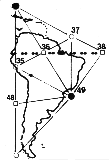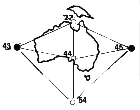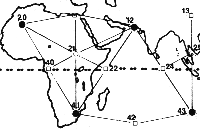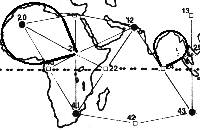 |
| And so, Hapgood's theory explained that at various points in time, the landmass of Antarctica would move out of the coldest regions, by Earth Crustal Displacement. And, he certainly wins "brownie points," since the best scientist who ever lived substantiated his theory. [4:44 p.m. as of this moment.] All of the facts that we discussed earlier from Gregg Braden, regarding the rise in the Earth's "heartbeat" and decrease in its magnetic field strength, are identical to those phenomena observed in previous cases of magnetic pole shift, which could well be "Earth Crustal Displacement" in action. Wilcock's reading 53-29, listed in the last chapter, says that the first of a series of these motions is soon to occur (as of Jan. 29, 1999.) We will have to wait and see if this indeed comes true. We can see that if Hapgood's theory is correct, the Atlantean inundation was the most recent example of this displacement, as prior to this point, many maps were drawn of Antarctica without ice. Therefore, the shifting Earth's crust must have positioned Antarctica in a warmer area before the most recent displacement. So, Hapgood's model is the best conception that we have for why Antarctica would be in a warmer region. Along with Fingerprints of the Gods, the book When the Sky Fell by Rand and Rose Flem-Ath also goes into far more hard scientific detail on this than we will here. The other maps that also showed Antarctica under the ice included the Oronteus Finaeus map of 1531. In this case, we get a complete view of Antarctica, with the edges largely uncovered by ice. Rivers and mountains are clearly visible. Another very similar map was produced by Gerard Kremer, known to the world as Mercator, the author of the modern Mercator map projection that is now so commonly used. Hapgood concludes that Mercator had access to other source maps besides those used by Oronteus Finaeus, since many recognizable features of Antarctica are more clearly visible in his work. So, there were definitely several copies floating around. Another mapmaker who demonstrated equal sourcing and knowledge was Phillippe Buache, a French geographer of the eighteenth century. His 1737 map shows us a version of Antarctica that apparently has no ice on it at all! There is a clear waterway that runs straight through the middle, dividing the continent into two main landmasses, one large and one smaller, perhaps a sixth the size of the larger. [Note that we are not including these pictures, as this chapter is already quite large in download time from all of the Global Grid images below. These points about the ancient maps are not central enough to our argument to justify the increase in download time.] What makes this even more amazing is that the Buache version of Antarctica is nearly identical to what we actually discovered in 1958, as a part of International Geophysical Year. In this case, a comprehensive seismic survey of the "subglacial topography" of Antarctica was conducted. And indeed, the separation between the landmasses, shown in the Buache map as a waterway, is in almost exactly the same place. Both the smaller and larger landmass in the Buache map are very closely approximated by the findings of the scientists in 1958. |
 |
| As Zecharia Sitchin and others have pointed out, the Sumerian civilization certainly seemed to spring up quite spontaneously and dramatically. In an amazingly short amount of time, they had written language, education, laws, agriculture and running water, among others. We know that the Sumerians had the Constant of Nineveh, the cycle we discussed earlier. Then, when we factor in Zecharia Sitchin's deeper work as well, we realize that a group that had access to incredible technology aided the Sumerians, a group that possessed flying machines, lasers and other exotic equipment. A very advanced understanding of science and physics was present as well, including the knowledge of the full spectrum of planets in the Solar System. We are also told in the ancient Hindu Vedas and the Cayce Readings that Atlanteans did indeed possess flying machines, so this checks out. (It also could be that the Atlanteans were cooperating with Space Brothers that they had interacted with as well, given the preponderance of "Ancient Astronaut" data that is available. Sitchin's data very strongly suggests the existence of the Annunaki, or "Those who from Heaven to Earth Came.") The maps were kept within the high ranks of the priesthood well after the start of the Sumerian civilization, and eventually, they were secreted into the Library of Alexandria in Egypt, and later into the academic halls of Greece. It is believed that only those who were members of the secret brotherhoods knew of the existence of these maps. The argument for the secret brotherhoods' existence is extremely strong, and the best book Wilcock has ever found on this topic is The People of the Secret by Ernest Scott, Octagon Press, London 1983. Scott's work leaves no doubt whatsoever that this Brotherhood existed, that it secretly allied the major religions of Christianity, Islam and Judaism, and that it still persists in the present moment as a positive group that communes with Higher Intelligence and seeks to gradually unveil the Mysteries to our civilization. It is indeed very interesting material, but if we try to take on Scott's incredible and highly academic arguments, we would have to write a whole new volume for this book! So, these brotherhoods sent out seafaring explorers to rediscover the lands that were hidden on their secret maps, to eventually rebuild a great, technological civilization like Atlantis. Francis Bacon, the father of modern Freemasonry, declared the American continent to be the site for the "New Atlantis." And, in order to set this plan into action, the explorers themselves would need to copy over the maps, at least in part, so that they would have something they could work with. Certain authors including Hancock in Fingerprints of the Gods speculate that Columbus had access to these maps, and therefore knew that the Earth was actually round, and that new lands would be found overseas. All of this proved to be quite interesting to Ivan P. Sanderson, the "father of the Grid," and now we will see why. The first explorer that we are aware of who copied over one of these maps is Admiral Piri Reis, in 1513 AD. This map focuses on Africa's west coast, South America's east coast and the northern coast of Antarctica. What is so interesting is that it shows the Antarctic Queen Maud Land area as an ice-free coast. And, as Hancock writes in Fingerprints, in order for this coast to have been surveyed without ice, it would have to have been mapped between 13,000 and 4,000 BC! Modern humanity did not know the outline of this coast until 1949, as a result of a comprehensive seismic survey by a joint British-Swedish reconnaissance team. (Hancock 1995, pg. 12.) |
| The man who put all of this map information together is Charles Hapgood, however his theories did not initially start with these maps. Hapgood was a History of Science professor at Keene College in New Hampshire, although his areas of inquiry obviously went far beyond simple history. Hapgood's basic theory concerns Earth crustal displacement, a close analog to the idea of "pole shift," where the surface of the Earth actually changes position. Hapgood says that the entire surface crust of the Earth "may be displaced at times, moving over the soft inner body, much as the skin of an orange, if it were loose, might shift over the inner part of the orange all in one piece." This theory drew the attention of Albert Einstein as well, who contributed the forward to Hapgood's 1953 book. Einstein's quote, reprinted on pg. 10 of Hancock's book, is definitely worth inserting here: I frequently receive communications from people who wish to consult me concerning their unpublished ideas [Einstein observed]. It goes without saying that these ideas are very seldom possessed of scientific validity. The very first communication, however, that I received from Mr. Hapgood electrified me. His idea is original, of great simplicity, and - if it continues to prove itself - of great importance to everything that is related to the history of the earth's surface. Einstein also expressed his own ideas as to how this earth movement might occur: In a polar region there is continual deposition of ice, which is not symmetrically distributed about the pole. The earth's rotation acts on these unsymmetrically deposited masses, and produces centrifugal momentum that is transmitted to the rigid crust of the earth. The constantly increasing centrifugal momentum produced in this way will, when it has reached a certain point, produce a movement of the earth's crust over the rest of the earth's body�' |
| So obviously, this is a highly interesting phenomenon, and it goes hand in hand with the work of Carl Munck. Hapgood's work, which again caught the academic interest of Einstein, provides the foundation for understanding why the Ancients would have known the global coordinates as exactly as they did. We now come back to Ivan P. Sanderson, who also studied Hapgood's work and was mystified by these incredible pieces of evidence. Sanderson sought to figure out how these ancient mapmakers were able to plan out a full, global map. What type of models would they need to have in order to do something like this, and use it? How did they break the Earth's surface up into measurable units? And furthermore, was there anything that was physically observable and measurable in the vastness of Earth's oceans, so that these mapmakers would actually know where they were in the middle of the sea? Sanderson worked on this puzzle with several associates throughout the 60s and into the 70s. He tackled huge volumes of data, mostly from anomalous reports declared by hundreds of pilots and mariners, and systematically organized them. His results proved beyond a shadow of a doubt that some very interesting anomalies were visible in certain areas of the Earth's oceans. |
| By now, the reader should not be surprised when we restate that Sanderson's twelve symmetrically spaced vortices do indeed graph out one of the Platonic solids, namely the icosahedron. This is indicated in the following illustration from Nicholas R. Nelson's book Paradox (Dorrance & Co., Ardmore, Penn. 1980,) reprinted in David Hatcher Childress' book, Anti-Gravity and the World Grid (Adventures Unlimited Press, Box 74, Kempton, Illinois 60946: 1987, 1995.) (We digitally altered the image to preserve its simplicity in a small .JPG format.) Sanderson's popular work certainly ignited a firestorm of interest worldwide. The problem was quickly picked up and tackled by a group of three Russian scientists: Nikolai Goncharov, a Muscovite historian, Vyacheslav Morozov, a construction engineer and Valery Makarov, an electronics specialist. These three scientists worked directly off of Sanderson's research, and the twelve points of the icosahedron were placed in almost the exact same location. But, these scientists also added 50 more points, by superimposing a dodecahedron onto the Grid as well. |
 |
 |
 |
| These anomalies are all very familiar to us, as being those commonly reported in the Bermuda Triangle. This was certainly one vortex that interested Sanderson immensely, although there were other areas that were much more neglected as well. Using statistical analysis to crunch all the data together, concerning all the different places where these events occurred on the globe, Sanderson was able to derive twelve common points of anomalous occurrence on the Earth. Amazingly, these twelve points were all equally, harmonically spaced from each other! The effects of these "vile vortices," as he called them, included not only disappearances but apparently time-warping events as well. Many of these were recorded in books such as Charles Berlitz's The Bermuda Triangle, but Sanderson found evidence for these time-space disturbances in the other vortices as well, not just by Bermuda. For example, one of Sanderson's vortices was located near Hawaii. He found a report of a pilot, flying with passengers very near this zone, who suddenly lost all of his instruments as well as radio communications. This is called a "dead zone," or "flying blind," with no ability to radio for help or to determine altitude, position, et cetera, except by "eyeballing" it. The pilot continued to fly for roughly 350 miles in this "dead zone," without being able to connect with anyone on the radio; anywhere from 30 minutes to an hour, depending on his speed. Finally, the bizarre experience came to an end, and he was very relieved to be able to get in touch with the tower yet again. We can imagine the panic and astonishment that must have been in his voice, narrowly avoiding danger and wondering what the heck had just happened. What was so amazing and unexpected was that according to the tower officials, no time had elapsed between his radio contacts! In other words, at one moment he was speaking to them normally, and ten seconds later he was in a panic, telling them that he had flown 350 miles without any instruments! As amazing as it must seem to our "common sense," all passengers aboard this aircraft must have passed into a higher dimensional frequency, where they were not affected by time. The cause of this effect was the hyperdimensional energy that was harnessed by the "vile vortex" they were flying through. |
| Their results produced the following map, first printed in the popular Soviet science journal Khimiyai Zhizn, (or Chemistry and Life,) reproduced in Anti-Gravity and the World Grid: These three scientists worked off of their combined talents to determine this "matrix of cosmic energy" that encircles the Earth. With this new formulation of the Global Grid, Becker and Hagens write:These new lines and points, in conjunction with Sanderson's, now matched most of the earth's seismic fracture zones and ocean ridge lines as well as outlined worldwide atmospheric highs and lows, paths of migratory animals, gravitational anomalies, and even the sites of ancient cities. Becker and Hagens' attention was drawn to this research through the work of Chris Bird, who wrote his article on the "Planetary Grid" in the New Age Journal of May 1975. They were so overwhelmed with this new information that they eventually set up a meeting with him to discuss the work. Soon after this, they "completed" the Grid, making it compatible with all the Platonic Solids, by inserting a creation from Buckminster Fuller's work |
 |